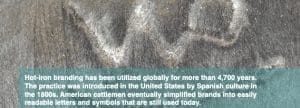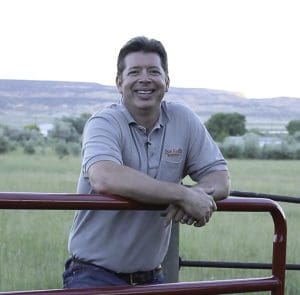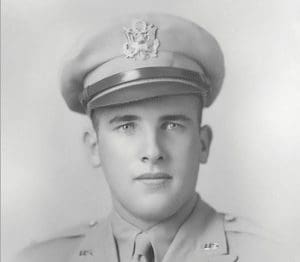By Patti Wilson, Contributing Editor
In a world of technology that’s advancing at the speed of light, there are one means of traceability that is permanent, visible, and virtually indisputable: the hot iron brand.

The iconic practice of branding has been in use for more than 4,700 years, an “in-your-face” fact for various other modern methods that have proven undependable or otherwise imperfect. The smoking gun (or hide) that cements this reality is an ancient Egyptian tomb painting illustrating a cattle gathering and branding.
Other tombs dating back to 2000 B.C. contain hieroglyphics on walls describing the branding of cattle. Ancient Romans left a history of hot brand use, as well. A Shift Into Modern Times Time passed and areas of the European continent became agricultural. Spain, in particular, grazed large numbers of cattle on commons, intermingling herds prior to the advent of fencing. Hot-iron branding took another step forward in traceability. European practices eventually made their way to North America, and Spanish traditions made a huge impact on livestock production. Mexican vaqueros brought their branding customs north, and, soon, American cattlemen were heating irons to mark their cattle. A large area of our Southwest was grazed, unfenced, by Mexican ranchers alongside newly hatched American entrepreneurs. Branding became imperative.
Cowboys carried books in their pockets to keep track of who belonged to whom while struggling to read brands. This is, I assume, where the word “pocketbook” was derived. A Marked Change Mexican brands were a tough inscription. Many were unreadable, being perhaps an attempt to reproduce a family symbol.
They are described in an article by the Cowboy Accountant Cowboy lifestyle as “pictographs.” An original brand was adapted as a family’s sons acquired his own cattle. Over the period of a generation, the original brand would have gained additional curlicues, pendants and serifs attached, adding to the confusion. These complicated markings were employed well into the late 1700s. It may have been 1840 before American ranchers began to simplify readable brands in the great U.S. Southwest. In 1848, the new state of Texas passed a brand law providing prosecution of stolen cattle with a registered brand. By the 1870s, many West Texas counties had established brand registries with practical, efficient characters. Today, each state handles their brand laws independently. Texas, for example, continues county-controlled brand registration.
Nebraska brands, in contrast, are recorded under a statewide office. Brand inspectors not only establish ownership for lost or stray cattle, but they solve crimes. They are another arm of the law and can make arrests, if needed, for non-livestock criminal activity. Reflections of a Brand Inspector Every office must have dependable people to make it successful. I visited with Dwain Inness, retired brand inspector, of Ravenna, Neb., about his time working for the Nebraska Brand Committee. Many thanks go to Dwain and his wife, Dee, who keeps an impeccable, informative scrapbook documenting Dwain’s career.
Inness’s life tells you about the kind of person who becomes a brand committee CHUTESIDE MANNERExploring the Frontier of Animal HealthThe Most Dependable Means of Traceability By Patti Wilson, Contributing Editoremployee. His career spanned from 1978 to 2013 – 35 years of commitment and adventure. An Appropriate Background Ranch-raised near Burwell, Inness served our country for a year in the infantry during the Vietnam War. Upon returning home, the young man spent several years healing up from that experience by traveling. Inness explained he “wanted to see what was over the next hill.”
He graduated from farrier school at Mineral Wells, Texas, and began the life of a ranch cowboy. Working on spreads from Texas to Montana, he would spend a year at each location before moving on to the next job. When his itchy foot was satisfied with travel, it was time to settle down, and he headed back home to Nebraska. The Life of a Brand InspectorAsked why he wanted to become a brand inspector, Inness shrugged and said, “At first it was just a job.” Applying for a position, he was admitted to training in Kearney in 1978. By ’79, he realized he liked it, and knew he “was going to stick with it.”
There was something different going on every day, he explained. All of it was good, especially interacting with the farmers and ranchers, seeing the country and working outside.
“Cold weather never bothered me,” he said, “I just put on more clothes.” Every Nebraska brand man spends a great deal of time at auction markets and packing plants. Inness was no exception. Along with regular hours, he was on call weekends and filled in for co-workers who were sick. Working close quarters with cattle isn’t always safe, either. He was only injured once, run over by a steer at a sale barn and rendered unconscious.
He explained that a friend hauled him into a local hospital and he was later sent home with a concussion. “It didn’t change anything at work,” he said. Results of a System That Works The most rewarding and satisfying part of an inspector’s job is catching a cattle thief. Yes, there are cattle thieves in Nebraska. Beware of Inness. In March of 2001, he was called to Kearney Livestock Market after an older man got away with 25 cows and two bulls, which he had loaded out himself. A report went out to Nebraska Law Enforcement and help was requested from the community.
Inness related that, with the aid of citizens who called to report suspicious activity, the thief was apprehended. The perpetrator had taken the cattle to his home; they were only part of a 114-head heist of livestock from multiple sites reaching nearly to the South Dakota border. The thief was convicted and sentenced to a ten-year jail term. Inness smiled quietly and said, “When you get somebody like that, it makes you feel good.” A great illustration of a brand inspector’s job involves an incident that took Inness to a Phelps County feedlot in 1993. Arriving at the site, he was met by the Phelps County Sheriff and deputies who happened to be looking for evidence in a drug case.
It just so happened that the cattle shenanigans he was called to inspect were tied into a drug deal. After searching a building unsuccessfully for evidence, the local law enforcement was frustrated. Inness searched through the same building later and found it: an ornately carved wooden box hidden beneath the rafters. It contained a treasure of drugs and paraphernalia, enabling the conviction of the perpetrators. Inness received a citation of merit from Phelps County authorities. Dee Inness’ scrapbook was peppered with many success stories, gleaned from newspapers. Certificates of merit, articles about co-workers and activities of the Nebraska Brand Committee over 35 years illustrated the full life of a respected employee.
There’s a great deal of value in brands, branding and the good people who work to encompass the safety of our livestock and community. Thank you to them and to you, Dwain Inness. ANIMAL HEALTHHot-iron branding has been utilized globally for more than 4,700 years. The practice was introduced in the United States by Spanish culture in the 1800s. American cattlemen eventually simplified brands into easily






